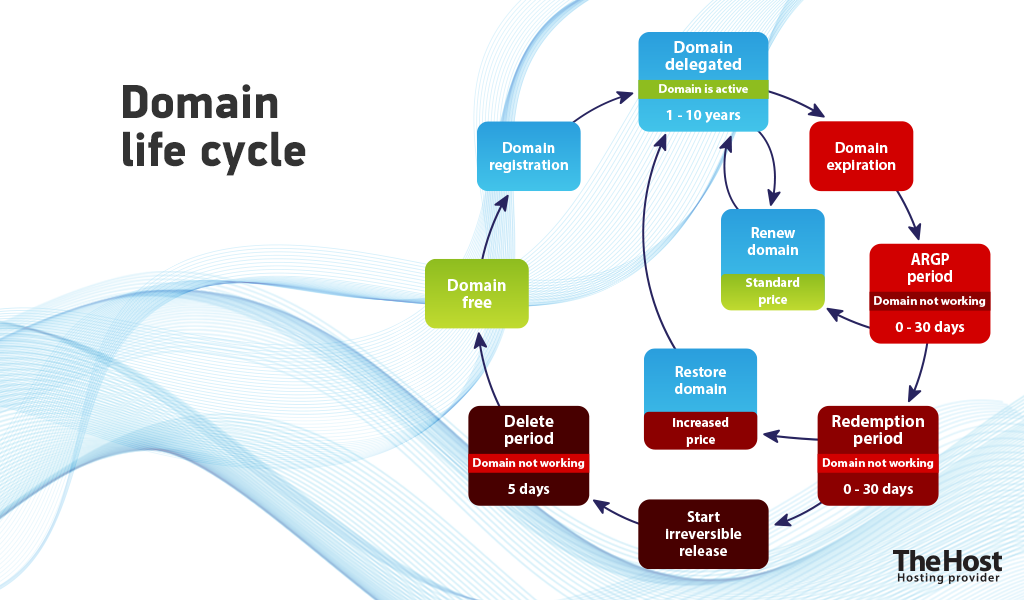2.1.2 Domain life cycle

A domain is a unique identifier for a website or web resource on the Internet. It allows users to easily find and visit websites, as well as ensures uniqueness and organization of online content. However, domains have a certain life cycle, which is determined by their current status.
The life cycle of a domain name is defined as the period from when it becomes available for registration until it is actually deleted from the domain registry. During this cycle, the domain name goes through certain stages. Let’s look at each stage in more detail.
Domain Name Status and Their Change Cycle

Available for Registration (Available)
In this phase, a user can choose a unique address for their site and register it. To do this, You need to check availability using domain search tools. The registration procedure is described in detail in our instructions.
Registered (Registered)
After successful registration, the domain enters an active phase:
- The domain is working, the site hosted on it is visible on the network and in search engines.
- For a working domain, the status in WHOIS will be
clientTransferProhibited,clientDeleteProhibited,ACTIVE,OK, or others. Depending on the domain zone, statuses may contain different values. - The owner can manage DNS settings, redirect the domain to another hosting, create subdomains, etc.
Auto-Renew Grace Period (AGRP)
This status appears immediately after the paid term of the domain expires. During this period:
- The domain still belongs to the owner but is marked as Expired in WHOIS. In the personal account, such domains are usually displayed as Registered(Not Delegated).
- The owner has the opportunity to renew the registration at the standard price in their personal account.
- The duration of the period is usually up to 25 days. Depending on the domain zone, the term may vary.
- If the domain is not renewed during this period, it transitions to the Redemption Period status.
Important: some domain zones do not have the AGRP status, the domain may transition directly to Redemption Period after the registration period expires.
Redemption Period
If the domain was not renewed during the Auto-Renew Grace Period, it enters the redemption phase:
- This is the last chance to renew the domain. The cost of renewing a domain that is in the Redemption Period status is usually 5-15 times higher than the cost of a normal renewal. Our Support Service will be able to give you the exact price.
- Renewal through the personal account is not available. For restoration, You need to contact Support Service.
- The duration of the period is usually up to 25 days. Depending on the domain zone, the term may vary.
Important: some domain zones do not have the Redemption Period status, the domain may transition directly to Pending Delete after the registration period expires.
Pending Delete
Without restoration at the Redemption Period stage, the domain enters the deletion queue:
- The phase lasts 5-15 days.
- The domain is deleted from the registry and no longer belongs to the owner.
- It cannot be restored, transferred to another registry, or have its owner’s data changed.
- After this phase ends, the domain becomes available for new registration.
Understanding each stage of a domain’s life cycle helps owners effectively manage their online resources, timely renew registration, and avoid losing their domain name.
Importance of Timely Renewal
Domain owners are recommended to renew their domain name registration in advance to avoid transitioning to Auto-Renew Grace Period (AGRP) or Redemption Period status. Both statuses will lead to suspension of domain delegation, consequently Your site will stop working. We provide the option of automatic renewal, which significantly simplifies this process.
We inform: risks of domain loss and its consequences
Deleted domains may have a certain history and authority in search engines. Other sites might have linked to them, which can bring traffic to the new owner. However, one should be careful, as the link profile might turn out to be of low quality due to a large number of spam links.
Domains with high authority and good history are recommended to be restored before their deletion from the registry. Such domains are valuable assets and can be quickly intercepted by others after release.
-
Domains with good history and authority can have significant value in the secondary market, especially if they are associated with a popular niche.
-
Losing such a domain can lead to the loss of established positions in search engines and constant traffic.
-
Competitors or cybersquatters may specifically track the expiration of valuable domains to intercept them immediately after deletion.
Important to remember: after going through all stages of deletion, the domain becomes free for registration by anyone. This means that any person can register Your former domain and You will lose the right to it.


